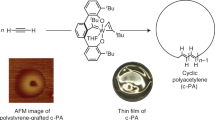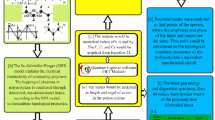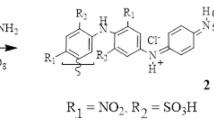Abstract
Although the synthesis of polyacetylene powders was first carried out many years ago, Ito et al.1 have only recently obtained films which can be doped with various chemical species, such as I2, SbF5 or Na, K, giving p or n type semiconductors. These and other properties, such as its optical bandgap2 (Eg ≈ 1.5 eV) have made polyacetylene an interesting material for study3–6. Its mechanical stretching ability, for example, leads to partially oriented fibrils and an electrical conductivity anisotropy γ;¶/γ⊥≃10 has been measured7 with γ¶ reaching 3×103 Ω−1 cm−1 when highly doped with AsF5; roughly 12 orders of magnitude higher than the value measured on undoped cis (CH)x. Polyacetylene is available in two isomeric configurations (cis and trans, Fig. 1). More than 98% cis isomer is obtained if the synthesis is performed at low temperatures (−78 °C) but it is not thermodynamically stable and becomes trans on increasing the temperature, the total transformation occurring when T > 100°C. Any doping process induces a partial cis/trans isomerization8. The exact conduction mechanism is poorly known: the localization and nature of the doping species have been widely discussed. Here we investigate, using scanning electron microscopy, the behaviour of the morphology of (CH)x films when the dopant concentration varies. Starting from the fibrillar structure we have observed the formation of aggregates and a uniform melt of various globular features at high doping levels. Our results yield information on how the electrical conductivity takes place in these non-uniform materials.
This is a preview of subscription content, access via your institution
Access options
Subscribe to this journal
Receive 51 print issues and online access
$199.00 per year
only $3.90 per issue
Buy this article
- Purchase on SpringerLink
- Instant access to full article PDF
Prices may be subject to local taxes which are calculated during checkout
Similar content being viewed by others
References
Ito, T., Shirakawa, H. & Ikeda, S. J. Polym. Sci., Chem. Educ. 12, 11–16 (1974).
Fincher, C. R. et al., Solid State Commun. 27, 489–491 (1978).
Chiang, C. K. et al. J. chem. Phys. 69, 5098–5104 (1978).
Park, Y. W. et al. Solid State Commun. 29, 747–751 (1979).
Fincher, C. R. et al. Phys. Rev. 19, 4140–4148 (1979).
Baughman, R. H., Hsu, S. L., pez, G. P. & Signorelli, A. J. J. chem. Phys. 68, 5405–5409 (1978).
Heeger, A. J., Mac Diarmid, A. G. Proc. NATO ASI, Tomar, 353–402 (1979).
Lefrant, S. et al. Polymer. Commun. 21, 1235–1237 (1980).
Rolland, M. et al. Phys. Status Solidi A68 (in the press).
Epstein, A. T. et al. Preprint (1981).
Rice, M. J. & Timonen, J. Phys. Lett. 73A, 368–370 (1979).
Mortensen, K. et al. Phys. Rev. Lett. 45, 490–493 (1980).
Author information
Authors and Affiliations
Rights and permissions
About this article
Cite this article
Rolland, M., Aldissi, M., Bernier, P. et al. Morphology of iodine-doped polyacetylene. Nature 294, 60–61 (1981). https://doi.org/10.1038/294060a0
Received:
Accepted:
Issue date:
DOI: https://doi.org/10.1038/294060a0
This article is cited by
-
Morphology of iodine-doped polyacetylene
Nature (1983)
-
Morphology of iodine-doped polyacetylene (reply)
Nature (1983)



